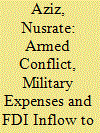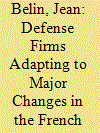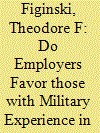| Srl | Item |
| 1 |
ID:
164532


|
|
|
|
|
| Summary/Abstract |
This paper investigates the relationship between military expenditure and FDI inflow conditioning on the exposure of a country to armed conflict in the long run. We apply the band spectrum regression estimator, and the maximal overlap discrete wavelet transform, to a panel of 60 developing countries, for the years 1990 to 2013. The estimated results indicate that military expenditure, in the absence of armed conflict, reduces FDI inflow. However, the negative effect is mitigated by increased military expenditure, in the presence of armed conflict. We also show that the effect of military expenditure on FDI is time sensitive, in that it takes time for military expenditure to affect FDI inflow. FDI inflow in response to higher military expenditure is higher for the country that faces higher armed conflict than the country that faces lower armed conflict. The findings are robust in the case of overall as well as internal conflict. These results are also robust to the alternative specification, subsample analysis with different armed conflict thresholds, and the estimation using the time variant long-run models.
|
|
|
|
|
|
|
|
|
|
|
|
|
|
|
|
| 2 |
ID:
164526


|
|
|
|
|
| Summary/Abstract |
The structural changes inside the French innovation system have impacted the role of defense firms since the late 1980s. Major changes have affected the defense budget and public R&D funding system in particular. The aim of this article is to understand French defense firms’ repositioning within the National Innovation System (NIS) based on an analysis of their R&D behavior over a long period of time (1987–2010). We show that French defense firms remain major players in the NIS and faced up to these major changes by adapting the funding of their R&D and their research priorities and rolling out new innovation capabilities. Additionally, they developed new innovation models to take advantage of new collaborative partnerships developed for civil and military markets.
|
|
|
|
|
|
|
|
|
|
|
|
|
|
|
|
| 3 |
ID:
164530


|
|
|
|
|
| Summary/Abstract |
This study examines whether completed service in the military reserves results in a civilian labor market benefit. Reservists are not completely absent from the civilian labor market during their military service, possibly allowing them to receive the benefits associated with military experience without forgoing valuable civilian labor market experience. Using a resume study, the results suggest that completed service in the military reserves, relative to no military experience, increases the probability of receiving a request for an interview by 19%.
|
|
|
|
|
|
|
|
|
|
|
|
|
|
|
|
| 4 |
ID:
164528


|
|
|
|
|
| Summary/Abstract |
The aim of this article is to evaluate how French Major Conventional Weapons (MCW) exports impact on the conflict intensity of recipient countries. The recent increase in French arms exports seems to contradict the French political discourse on the promotion of regional stability. We run zero-inflated ordered probit model in order to analyze the role of the arms trade on the intensity of civil conflicts in 144 countries from 1992 to 2014, using SIPRI and UCDP/PRIO data. Our results suggest that French MCW exports tended not to exacerbate intrastate conflicts during this period. This finding is robust to changes in the empirical framework. We propose two lines of explanations: France seems to be prone to choosing partners that respect human rights and selling more ‘defense-oriented’ MCW than the rest of the world.
|
|
|
|
|
|
|
|
|
|
|
|
|
|
|
|
| 5 |
ID:
164531


|
|
|
|
|
| Summary/Abstract |
We examine the validity of the guns-versus-butter hypothesis in the pre-Arab Spring era. Using panel data from 1995 to 2011 – the eve of the Arab uprisings – we find no evidence that increased security needs as measured by the number of domestic terrorist attacks are complemented by increased military spending or more importantly ‘crowd out’ government expenditure on key public goods such as health care. This suggests that both expenditure decisions were determined by other considerations at the government level.
|
|
|
|
|
|
|
|
|
|
|
|
|
|
|
|
| 6 |
ID:
164529


|
|
|
|
|
| Summary/Abstract |
This article offers a comprehensive analysis of the database ‘Mémoire des hommes’, which is a record of more than 1 million French soldiers officially recognized as dead during the World War I (WWI). Integrating this source with the 1911 census, we evaluate the potential numbers of recruits by French regional department. From this, a model identifies the factors affecting the number of deaths. While demographic factors are the principal determinants, adding significant economic, political and spatial factors reduces the unexplained variance between regions and significantly improves the explanation of the disparity in the number of deaths by region.
|
|
|
|
|
|
|
|
|
|
|
|
|
|
|
|
| 7 |
ID:
164527


|
|
|
|
|
| Summary/Abstract |
In the context of restricted budgetary resources and the growing cost of maintenance, repair, and overhaul (MRO) activities, a major issue for modern armed forces is to sustain defense platforms. A possible method consists of realizing economies of scale through the concentration of maintenance activities, which involves the spatial reorganization of existing industrial sites dedicated to MRO. This article provides a formalized framework to discuss the optimal organization for the MRO of defense platforms in space. The public planner organizes the maintenance of defense platforms with only two possible spatial configurations. In the dispersed configuration, two industrial production units in charge of the maintenance optimally cover space, whereas in the concentrated configuration, a unique industrial unit covers space. Focusing on the tipping point between the two configurations, the balance of forces between agglomeration and dispersion in defense support activities is described and discussed. On the one hand, economies of scale provide an opportunity to optimize defense support costs, favoring concentration in a unique industrial unit. On the other hand, space causes dispersion to reduce both transport costs and operational social costs. This trade-off illustrates a general principle in spatial economics with an application to MRO production in the French case.
|
|
|
|
|
|
|
|
|
|
|
|
|
|
|
|